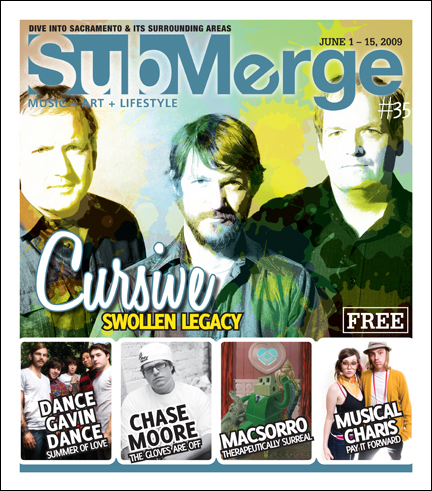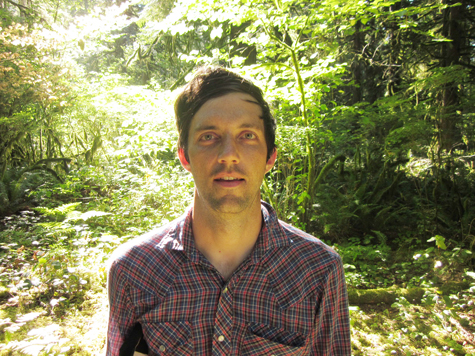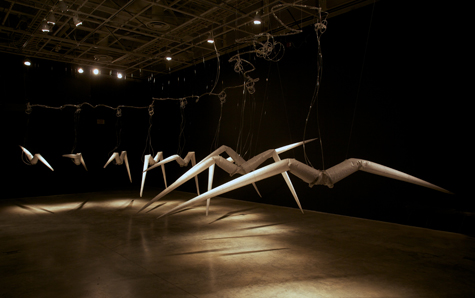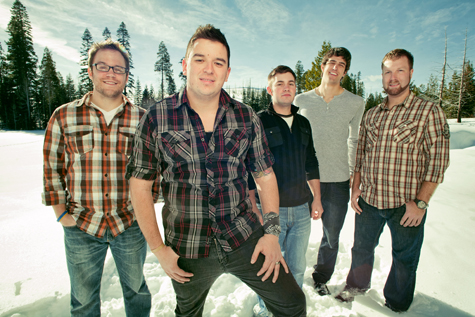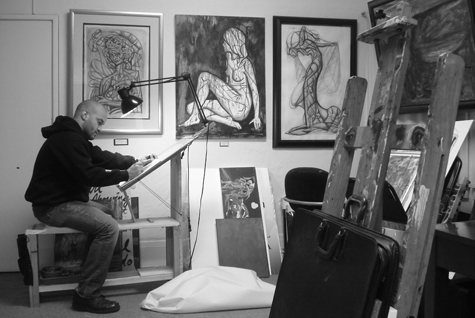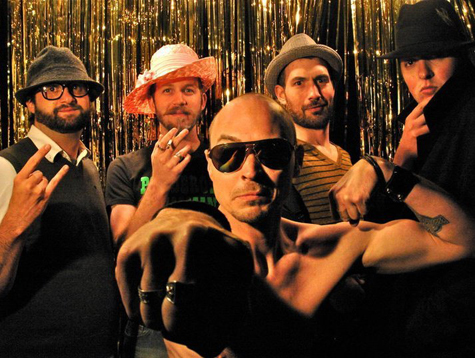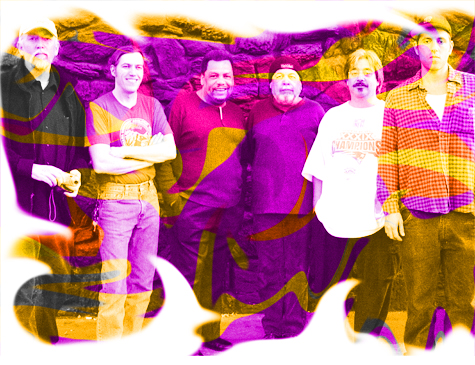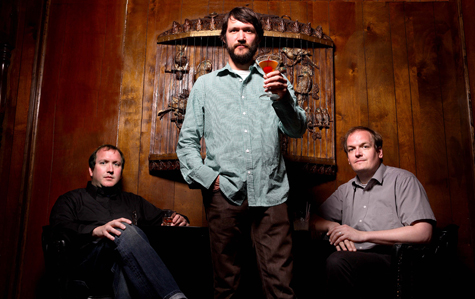Beyond Teenage Politics: MxPx at 20
Being a teenager in the ‘90s in California meant you listened to punk rock. If there were other choices in the matter, no one presented them as voraciously as labels like Fat Wreck Chords, Epitaph, SideOneDummy, Nitro or Hopeless did. And while California’s skate-punk tsunami swelled during the early part of that decade with the rise of Green Day, Offspring and Rancid, miles away were groups hell-bent on riding the wave. Bremerton, Wash.’s MxPx probably weren’t trying to become a ubiquitous tandem of the ‘90s punk rock explosion, but they’ve definitely become one of its most ardent flag bearers.
MxPx is on a stop-and-go nationwide tour, packing venues old and new, big and small on what they’ve decided to embrace as their 20th Anniversary Tour. That’s right, it’s been 20 goddamn years since the fresh-faced, bleach-haired trio formed, eventually releasing seminal skate-pop-punk albums Teenage Politics and Life in General on Tooth and Nail Records.
Almost from the beginning, the band’s fast-paced, slick patina of pop and punk raised eyebrows. Bassist Mike Herrera’s sleek, peppy songwriting and humor-pocked anthems (think “Punk Rawk Show” and “Chick Magnet”) were a huge hit with the Christian punk underworld, and–somewhat begrudgingly–punk purists. With guitarist Tom Wisniewski and drummer Yuri Ruley rounding out the trio, MxPx at 20 is still whip-crack pop-y, maybe a little more mature, and definitely still relevant.
But why? From Wisniewski’s own admission, there were no enormous expectations for MxPx.
“We never really had much of a plan,’” said Wisniewski, who joined the band in 1995 shortly after original guitarist Andy Husted departed. “We just kind of went with it.”
Embracing the immediacy and uncertainty of their lives at the time (the band members were 15 years old when they got together), Wisniewski explained that for MxPx, everything sort of snowballed–quite literally for him at the beginning of his tenure.
“[My first show with the band] was in Portland [Ore.] at this place called the Push that’s not there anymore,” Wisniewski recollected. “There were tons of people going crazy, and it was just like, ‘This is amazing! This is the best show we’ve ever played!
“We sold a bunch of merch and ended up staying with some fans over across the river in Vancouver, Wash., that night because we didn’t wanna drive back. We woke up in the morning and someone said, ‘You’ll never guess what happened last night. It dumped like a foot of snow.’ So we ended up getting snowed-in with these people. We were just supposed to wake up in the morning and leave, but we ended up hanging out with them until around dinner time when the roads cleared up.”
Throughout the past 20 years, that kind of fan interaction (intentional or not) has helped MxPx somehow transcend genre pigeonholing they were weaned on. They routinely draw big crowds wherever they go, whether they’re headlining or opening. Case in point: during the band’s more recent appearances at ever-morphing mega-fests like Warped Tour, audience veterans would often forego the pull of top-billed vampire-core or saccharine-sweet electro-punk acts to be whisked away by the energy that made that tour–that Empire–what it is today. There’s loyalty with this band like there is with few others.
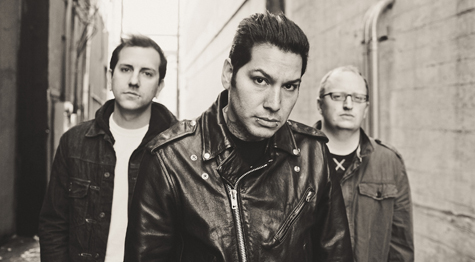
Photo by Jered Scot
Whether or not that loyalty is the result of MxPx’s underlying Christian roots–the band has never preached through its music, but openly admit to being Christians–is open for debate. What’s less abstract are the ways in which MxPx has persevered as a band through two decades of heavy touring, major label stints and growing older.
“There was always something right around the corner,” said Wisniewski. “It was always really busy so we never really had time to think, ‘Oh wow, this suddenly became a career. I paid my house off of this.’
“As far as us playing together, we all just love playing, we love the music, we get along really well. That’s that. As far as actually being able to stick it out and be a band and have people come to our shows that long, it takes work ethics. We worked really hard at making ourselves better, and being a better band live, and by being out there on tour all the time.”
Plans Within Plans, MxPx’s ninth studio album–and first release on their own Rock City Records label–was released in April, perpetuating the maturity of the band’s punk blueprint (“We wouldn’t write a song like ‘Bad Hair Day’ anymore,” joked Wisniewski), with catchy but aggressive rock and four-on-the-floor drumming. But the album was released five years after their last record, 2007’s Secret Weapon, which saw MxPx returning to the label that helped launch the band, Tooth and Nail.
Wisniewski said that with Herrera increasingly busy with his country-rock side-project Tumbledown, and with himself and Yuri settling into (gasp!) “real” jobs, the lengthy resting time in between MxPx records was anything but restful.
Despite that about-face toward reality, though, things remain business as usual in Bremerton.
“[When] Yuri and I got real jobs, that was kind of that moment of, ‘Oh gosh, reality is shutting in,’” said Wisniewski. “But it’s fun. I like my job, and I like being able to still play with the band, get in the van and go out for weekends. It was definitely an, ‘Oh, crap!’ kind of moment, but it’s worked out so far.”
The band’s been joined on stage during their 20th Anniversary Tour by a slew of special guests, including Mest’s Tony Lovato and Good Charlotte’s Benji Madden. It’s a safe bet that during their set at this year’s JoshuaFest–taking place Aug. 30 through Sept. 2, 2012 in Plymouth, Calif., at the Amador County Fairgrounds–the trio will beef up their ranks to accommodate their increasingly legendary status.
“The shows have been really good,” said Wisniewski. “We’ve been playing a mix of a little from here, there, everywhere throughout our career. Mike’s doing a little acoustic set in it, too. We’re just trying to make it better than our normal show.”
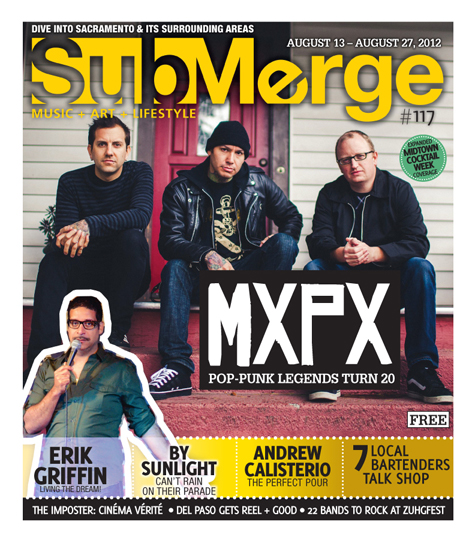
MxPx play JoshuaFest Friday, Aug. 31, 2012. JoshuaFest 2012 is held at the Amador County Fairgrounds in Plymouth, California. For more information on JoshuaFest, visit http://www.joshuafest.com/2012/home/. For more information on MxPx, including fall tour dates, visit http://mxpx.com/.
Blitzen Trapper Navigates Nostalgic Avenues on American Goldwing
The key word for the successes and attention over the last five years for Portland, Ore.’s Blitzen Trapper might have to be “patience.” With their conception in 2000 as a six-piece crew of classic-rock connoisseurs–anchored by the songwriting prowess of figurehead Eric Earley–Blitzen Trapper accidentally enjoyed an educational incubation period in garages and small clubs for a full seven years before anyone outside their hometown really had a clue or cared about them. With everyone seemingly looking the other way, the band honed their craft, wrote, recorded and released three albums on their own (2007’s Wild Mountain Nation would eventually be re-released on Sub Pop), and figured out, basically, how to be a band. With Wild Mountain Nation, Earley’s artistic prolificacy, and his isolation/inspiration of residing in the band’s actual studio space during the creation of the record, resulted in a buzz that’s ricocheting even today, complemented greatly by the 2008 follow-up, Furr, and the slightly prog-y 2010 LP Destroyer of the Void.
Blitzen Trapper’s latest release, American Goldwing, is a return to the nostalgic confines of road-weary rock, rumbling with gobs of groove, walls of squalling guitars and Earley’s typically brilliant strokes of capturing the nomadic spirit on tape. Big riffs and catchy choruses abound, showcasing a band maturing a mere 12 years after they first played a note. With the band’s ascent into the consciousness of media heads and music lovers alike having coalesced to form a formidable army of devotees, the band is capitalizing on their impeccable sense of timing yet again, hitting the road for another run of dates that will slither them out of the clubs and into the maw of the festival circuit through the spring and into summer. In anticipation of Blitzen Trapper’s gig at Harlow’s on March 5, 2012 guitarist/vocalist/keyboardist/melodica player Marty Marquis spoke with Submerge via phone from Seattle, where he was slated to headline at his friend’s wedding ceremony.
The band’s been off the road for a while now. How do you relax off tour? Do you tend to hibernate away from each other?
We hang out and do stuff now and again, but for the most part I think everybody’s got their own lives now. When we’re on the road, we enjoy each other’s company, but it’s nice to have a break from the enforced intimacy. I’ve got kids now; our bass player Mike [VanPelt] just had a kid a month ago. The other guys have their own things going on, too. When we started playing together in 2000, we weren’t like, “Let’s make a band and get famous and make a bunch of money!” We just liked hanging out, so we’d spend four or five hours a night, three or four nights a week. We did that for years, just hanging out, playing and recording. We’ve logged a lot of time with each other. We don’t feel the urge to do it all the time anymore.
Do you feel like folk, roots or Americana music is being homogenized by its resurgent commercial popularity? If so, is a band like Blitzen Trapper fearful of a backlash?
The thing to look at is how much of this music is actually folk-Americana music, and how much of it is just the trappings of that. I was hanging out with this guy last week, and he was talking about Mumford and Sons was Journey with banjos and acoustic guitars. There’s nothing wrong with that, but it’s just funny I guess. In the [late] ‘60s, no matter what style of music you were playing it was important to have long freaky hair and wear peace signs or have a fuzz guitar, making your music psychedelic regardless of where you were actually coming from musically. So bands are responding to all kinds of different pressures, and I think especially young bands who are talented but don’t necessarily have much of a sense of identity are apt to go for those folk-Americana trappings.
I don’t know about backlash. I feel like everything is so fragmented and Balkanized in music that it’s hard for me to imagine people being like, “Oh, we’re sick of this folk-Americana stuff!” There are a million other subgenres you can get into that will sell just as well probably.
Eric Earley has said that American Goldwing was written and at least partially recorded during your tour for Destroyer of the Void, and that it was hard playing the current songs when he knew that American Goldwing was the “real” record. Was that the sense for the rest of the band, or had you even heard those songs yet?
We’d heard a bunch of them. In my recollection, I think Goldwing was about half-done when we took off on tour for Destroyer. That’s been Eric’s motive; he’s ultra prolific. If he doesn’t actively stop himself from writing and recording, he’d be recording all the time. There were a lot of different things going on around the time we were putting together Destroyer. One of the things we were trying to do was build a consensus with all these different players–the band members, our label, our management–about what the record was supposed to be. I think because Destroyer wasn’t necessarily well-received, it was sort of easy to say that was a bad approach. It didn’t really represent what Eric as an artistic director was going for. He felt like Goldwing was a lot stronger of a representation of who he is as an artist, musician and songwriter. He felt great about the songs that were on it. On an objective level, the songs on Goldwing are coming from a more honest place than anything Eric’s ever put out before. It’s more about his life and less about fantasy stuff.
As a band, then, how do you reconcile that underlying feeling of having such a great album waiting on the shelf and you’re not able to play it because you have to tour for a different record that you worked on just as hard?
I think there’s always that thing where as an artist, you’re always most excited about what you’re currently working on. But there’s a delay in the music biz where your record comes out six or nine months after it’s finished. So you wrote these songs maybe a year or two before. You’re thoroughly familiar with them and you’re kind of tired of them. And then if nobody else in the world seems excited about these songs, it’s even more tempting to want to move on to the next round. But I don’t think that this narrative of American Goldwing being the “real record” is anything that all of us were thinking when we were touring on Destroyer.
I know Eric writes a majority of the songs, but what collaboratively is happening in the creative process? How informative are you in those processes when recording and writing, and the rest of the band as well?
I’m not very important at all in the writing and recording process. I came in on Goldwing and sang on some songs, but I didn’t play any guitar or anything. Brian [Koch], our drummer, was a lot more instrumental in arranging these Goldwing songs. I think he was a big part of why those songs turned out the way that they did on the rhythm side. I think also there’s this–I don’t know if it’s subliminal or what–but if you’re playing stuff in the van when we’re on tour, Eric’s going to pick up on it and incorporate elements of what he’s hearing, whether or not he realizes it. We’ve been talking about aesthetics and rock ‘n’ roll philosophy for a decade now, so I think we’ve all really influenced each other and been informed together. Also, I think while Eric’s in the studio arranging these things he’s thinking this stuff is going to be represented live by these players, here’s what they do well. He’s arranging these songs and thinking in terms of who we are as a band, as individuals. That’s not strictly collaborative, but I think it still affects the way the songs turn out. The more we go along and become a band, and it sort of crystallizes as a creative performance unit, the more it affects the way the songs end up on the record.
Is there a song that encapsulates the universality of that theme best on this record in your opinion?
Yeah, I think the title track is a pretty awesome song. It’s got a lot of abstract imagery, but it’s about travel, and the willingness to get on a vehicle and go. There’s sort of the spiritual thing that’s built into that song in particular, where the will to travel and the will to move places is somehow spiritually refining. But I think probably the best song on the record is the last one, “Stranger in a Strange Land.” It’s kind of the flip side of that: Once you stop moving, you don’t know where you are.
Catch Blitzen Trapper live Monday, March 5, 2012 at Harlow’s. Opening will be excellent alt-country Portland group The Parson Red Heads. Show starts at 8 p.m. and tickets are $15 in advance. Visit Harlows.com for more information.
Neal Morgan’s Impulsive New Record a Raw Delight
You’re likely at least a little familiar with Neal Morgan, even if the name doesn’t quite ring a bell right away. Fans of Joanna Newsom or Bill Callahan will recognize the name as belonging to the drummer responsible for holding down percussive duties on their respective tours the last few years, as well as on record–notably Newsom’s Have One on Me, and Callahan’s Apocalypse. But Neal Morgan, the solo artist, is something of an anomalous alter-ego to the drummer heard on those recordings. His 2009 debut solo record, To the Breathing World, premiered a symbiosis of voice-and-drums-only compositions, created largely from first impulses to a cassette boom box in his Portland, Ore., garage. The result was a unique, primal offering of polyphonic voice melodies cooing over sometimes-frantic, sometimes-structured drumming. For his newest album, In the Yard, Morgan has also added a spoken word element, a new passion he hopes his work evolves naturally toward.
The self-released In the Yard is out Jan. 24, 2012, with distribution help by Drag City. Morgan is returning to the Sacramento area on the heels of the release, and took some time to speak with Submerge regarding his muses, his music and his hatred of poetry.
Is there anything special about getting into the mindset of making a solo record for you, as opposed to your more regular gig of drumming for other people and being part of a unit?
Well, everything I do is based on first impulses. So even arrangements I’ve made for Bill’s music or Joanna’s music start as first impulses and then it goes from there. But those first impulses when I’m arranging for someone’s record are based on some amount of conversation in advance–what they might be hearing for a particular piece and talking about the piece itself, and then arranging for that. I guess having a blank slate is the major difference.
What draws you to want to create on that impulse, and to have the final product be a really improvisational vibe?
For my own artistic enjoyment, it’s most fun to just be playing and just to do it without thinking too much and editing while I’m working. I tend to like listening to records where it was clearly the first pass that someone made at something. I always love my friends’ demos more than their records, for example. Really early on, I didn’t know how to make music of my own. I thought, “Well you make some demos and then you make a record.” Why make demos? Just make it. Get in the garage and just start and end up in something. Not always, but most of the time I love the thing that happens first, when I wasn’t thinking, the fresh impulse. But after a certain point, I’m a heavy, heavy editor. I spend 20 percent of the time tracking and then 80 percent editing. It definitely flips; it goes from being this impulsive thing into this heavy cerebral experience.
Of the songs that aren’t improvised like “Father’s Day” or “The Evidence,” how do you reconcile getting into the mindset of arranging or composing those songs that are more structured?
Sometimes the first thing you did is just exactly what it needs to be. Sometimes that’s just what happens. There’s a need for further tracking and re-recording of initial impulses. There are a few moments like that on this album, like “Father’s Day” happened fairly quickly. Those initial impulses really just kind of happened. But there are a couple songs on the second side, one in particular–“Thinking Big”–I’d had that drum beat kicking around for a really long time. I decided I wanted to make a highly structured composition. But then the two spoken word pieces [“On Tour,” “I Stand on a Roof”] happened after I thought the record was done. I went away [on the summer 2011 Bill Callahan tour] and came back, and [the record] was very clearly not done with fresh ears. I recorded those in 20 or 30 minutes. It was exactly what the record needed, and I finished it right then.
Sometimes you have to take a step back and give it space…
Yeah. Do you know the painter Philip Guston at all? There’s a response on the record to him, and his painting is on the cover. I think about him a lot and read a lot of his writings and interviews. He talks about being led during the course of painting, and I think that happens. As these things start to show themselves, they kind of tell you which way to go.
What is your recording process like? I read you recorded some of the album on a boom box.
I have a cassette eight-track, and an old boom box that has a microphone. I have a digital program, but I’m not good at any of that stuff. I just wanna hit record and play. Side A [of In the Yard] is really a foreshadowing of what the next record is going to be. Side B is really a wrapping up, I think, of a lot of the ideas that started with the first album. The next one’s gonna be spoken word.
You mentioned you hadn’t really done any spoken word before. How did you get into that?
[I was] in Atlanta [with Bill Callahan], and I was opening the show there. I had just written something that I really liked, but I didn’t really have a melody or anything like that to sing it. I decided just to say it. I just tried it and I loved it.
Was it liberating? It takes a lot of confidence to release music that’s based on first impulses, but also to speak naked words that aren’t under the veil of a melody and just saying it.
Yes, it did feel that way. I think that maybe that’s what continues to draw me to spoken pieces. The next record will be that, because you’re right–it’s the barest of the bare. That show, for me, was an incredible show. My shows are almost always improv. I’ll just decide to play a song at the drum kit one night, or instead I’ll just sing that song. This was a night where I did four or five really new things that I’d never done.
What topics interest you most to write lyrics or spoken word pieces about? Is that also coming from an impulsive source?
I have a notebook, and I’m often writing. You write when an idea comes or something happens that you think is interesting, or you come upon a way to express something that you’ve been curious about. I do a lot of writing and no editing as I’m writing. Zero. I think that’s so important. Then I will look at it some time later, and sometimes nothing resonates for me so I don’t act on any of it. But sometimes pieces of it will resonate and will connect to other ideas I have at the moment. Maybe drum ideas, or they’ll connect to other things I’ve written. Now my process includes speaking those written words in the editing process, because I’m now thinking that way for live and for the next record–hearing how it sounds and seeing how it feels to speak particular lines and then making editing adjustments based on that.
Like working on cadence and intonation?
Yeah, which is all stuff that I’d never really explored before. But it’s all very rewarding for me right now. I also don’t have a lot of frames of reference necessarily, and I want to stay that way.
In terms of spoken word artists?
Yeah, and just for the written word. I don’t have a lot of writers who are heroes of mine in that form. I’m kind of limited in that way.
You haven’t gravitated toward spoken word artists, now that you really enjoy it artistically for yourself?
No, I haven’t done that. I’ve read some more poetry in the past year, but I like so little of it. It’s really wild. But I also don’t devour it. If I read a lot more, I’m sure I would find a lot more I would like. But I really hate a lot of what friends have given me and said, “Oh yeah, this is a great poet, a great book.” I just don’t like it, like 90 percent of it [laughs]. When I’m working on music, I tend to not want to hear much at all. I just want to keep those first impulses what they are without having other ideas flying around.
Neal Morgan performs at the Milk Gallery in Sacramento, Friday, Jan. 27, 2012. The show is all-ages and has a $5 cover. Show starts at 8 p.m. Morgan will also play at the Haven Underground in Nevada City Saturday, Jan. 28, 2012 (also a $5 cover). For more info, go to Havenunderground.org. Both shows feature Aaron Ross opening.
Artist Chico MacMurtrie Brings Inflatable Robot Technology to Davis
Rambling somewhere around the axis of where sculpture, engineering, robotics and puppetry collide lays the malleable artworks of Brooklyn-based visionary Chico MacMurtrie. For the past 20 years, MacMurtrie’s anthropomorphic mechanisms have taken on many forms, stimulating commentary on the meaning of movement, of life and of the ways in which viewers are allowed to interact with art, while at the same time examining how art interacts with the world at large.
For reference, take MacMurtrie’s large-scale installation, Birds–showing at the Richard L. Nelson Gallery at the UC Davis campus through Dec. 11, 2011Birds brings together a fleet of elegant bird-like creations, hung in a procession above snaking floor lights meant to represent a river. The installation utilizes some complicated mechanics, computers, a revolutionary inflatable architecture technology created by MacMurtrie himself, and very subtle robotics to produce an interactive demonstration. The inflatable technology, made of a light fabric, essentially allows the avian forms, though loaded with mechanical actuators and machines for movement, to approximate seamless, non-rigid organisms. The “bird” sculptures react to environmental sensors–triggered by the people in the room–by coming to life from a deflated form, to begin beating their wing-like appendages as if flying. Portraying qualities consistent with actual living systems, should a viewer get too close to the sculptures, or spend too much time ogling, they begin to devolve, or die, eventually crumbling back into their stasis one by one.
In short, it’s a provocative commentary on environmentalism, over-population, urban sprawl and more…with robots!
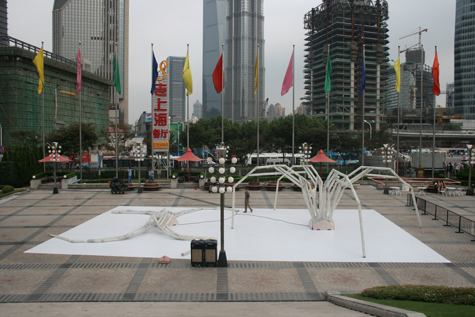
Inflatable Archit Growth Photo: Chico MacMurtrie / ARW
To give an accurate synopsis of MacMurtrie’s robotic sculpture work is nearly impossible, given that the more tangible elements of contemporary art remain satisfyingly absent in his work. Instead, MacMurtrie’s muse is derived from the examination of amorphic shape shifting, using robotics to bring to life geometrically abstract creations–most of them very big–to titillate viewers, and to bring a sense of symbiosis to the art-viewing ritual.
MacMurtrie’s sense of reinvention began during his undergrad college days at the University of Arizona. As a painter, MacMurtrie, 50, says he felt confined by the starkness of the canvas.
“My paintings got more physical, and ultimately I began literally throwing my body into my paintings, using my body as a brush,” explains MacMurtrie. “Ultimately, what I was after was the resulting effect of the paint on my body.”
When the paint had dried on him, the result left a kind of skin. MacMurtrie had an epiphany to move away from painting toward creating transformational performance pieces utilizing body skins. It wasn’t until he took the skins off that the seeds of what MacMurtrie now grows would be sown.

Inner Space - Photo: Chico MacMurtrie / ARW
“Once I emerged out of the skins, I noticed that the skins had a life of their own that was even more interesting and more powerful, in my opinion,” says MacMurtrie. “I began to figure out how to put sub-structures into these skins to animate them.”
MacMurtrie taught himself robotics, and began to see the world in mechanical systems. His new muse was to break down movements mechanically, while utilizing his background in sculpture to form a hybrid of the two. This process began with MacMurtrie’s creation of interactive robotic humanoids in the early ‘90s, collaborating with computer engineers and programmers, and has moved into his innovative work with inflatable robotic architecture. In order for him to progress, MacMurtrie literally had to reinvent the way the processes of construction and implementation were approached for his work–to move beyond robotic automation, and into abstract robotic sculpture.
Simply put, he’s not an engineer. But that doesn’t bother him.
“If I would have gone to engineering school, it would have inhibited [me],” says MacMurtrie. “Often, I’m doing things that are extremely difficult and challenging. People who have a practical understanding of engineering wouldn’t take those things on. I end up creating more work for myself because I’m not an engineer, but it’s more of a genuine process, I think.”
With lots of funding help, due in no small part to five grants from the National Endowment for the Arts, as well as funding from national, local and international granting agencies and 30 corporate sponsors, MacMurtrie and his collaborative group of artists, technicians and programmers–Amorphic Robot Works, founded in 1991–have created more than 250 mechanical sculptures that assume anthropomorphic and abstract forms that have been shown all over the world.
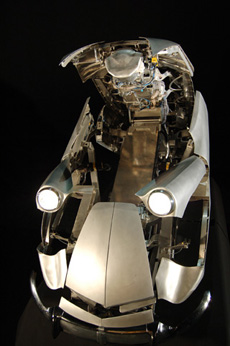
Totemobile - Photo: Chico MacMurtrie / ARW

Totemobile - Photo: Chico MacMurtrie / ARW
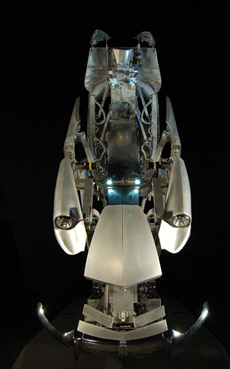
Totemobile - Photo: Chico MacMurtrie / ARW
Big examples of this work include Totemobile–a robotic sculpture that in its settled form appears as a life-sized representation of a 1965 Citroën DS automobile. During the performance process, the sculpture is disassembled robotically, growing slowly from the inside out to finally bloom into an organic 60-foot-tall totem pole. The result–which utilizes the inflatable technology–is a stunning pseudo-Transformers study of pop culture idolization and the inner-workings of organic labor that any construct of man was forced to endure.
With Birds, MacMurtrie tried to create an in-between point from Totemobile, and his early humanoid robots.
“[The birds] could be legs, they could be cones. They are certainly abstractions of birds,” explains MacMurtrie. “People see them as birds because they appear to have wings, and they appear to live and die, and they appear to take flight. They also have a pattern of becoming unified, then falling out of order. It resembles nature. It’s not so important that they are literally birds to me, as much as [viewers] get a sense of: they’re organizing the way nature organizes. They fall apart the same way that nature tends to fall apart.”
MacMurtrie says that the birds have received different reactions the world over. And while the abstractness of his work is true in a geometric sense, his hope is that it inspires people to think beyond the mechanics of his creations.
“The most important thing is that it’s alive, it has a life force, it’s trying to organize itself and trying to find its structure,” says MacMurtrie. “There’s a lot of social commentary [in Birds], but it’s extremely subtle. The birds work pretty much the same way we do. The difference is they’re fueled by air, and if we can’t breathe, we don’t live, and if we don’t eat fuel, we certainly don’t live. In this case, their air is fueled by electricity. It’s similar or parallel to our living.”
Birds shows at the Richard L. Nelson Gallery at Nelson Hall at UC Davis through December 11, 2011. Gallery hours are Monday through Thursday, Saturday and Sunday 11:00 a.m.—5:00 p.m. and by appointment Fridays. Call (530) 752-8500 for more information. For more about Chico MacMurtrie, visit Amorphicrobotworks.org.
Sacramento’s Not Your Style to Release Pop-Punk Debut In Season
Make no mistake about it: pop-punk as a revolutionary genre of music is quite dead. Even as a marketable way to sell skate decks, or dunks, or hair gel, it’s a goddamn apparition. But–and this is a big but–this is not to say that there aren’t times when you can relish in the finer glimmers in the flashes in the pan. Most everyone who digs pop music can appreciate the hook-y sensibility and heart-wrenching gloom of an old Saves the Day record, or a (A) New Found Glory EP. Where was I the first time I heard Blink 182’s Cheshire Cat? On Airport Road in Redding, Calif., after school on the way to Circuit City. See how that works? Those who experienced Lagwagon can’t tell fans of Panic! At the Disco about it and expect them to listen; just like those who wiggled to the spastic skate-punk of Descendents couldn’t expect Lagwagon disciples to “know” what it “really meant to rock!”
It’s for the reasons above that Not Your Style’s relatively tardy arrival to the pop-punk canon can be dismissed. Because inside all the premeditated naysaying hard-wired into critics who are interested in moving past frigid forms of expression, there lies that concession that every take is a new scene.
Not Your Style is resurrecting sunny melodies in Sacramento, and back-dropping them with crunchy riffs, four-on-the-floor rock drumming and saccharine-sweet lyrical imagery. It’s a formula that vocalist Laith Kayyali says has been honed over the last two years through heavy writing, recording and building a name for themselves. With a stated goal of becoming “the world’s greatest pop-punk band,” Kayyali and bassist Kylan Kegel laid the foundation of Not Your Style after the demise of their former alt-rock band, and a search through Craigslist to round out the crew.
“We wanted to take this more seriously and put a lot more time and effort into this band,” explains Kayyali. “We didn’t really go in with a lot of expectations. Things kind of just took off beyond anything we thought would’ve happened.”
After a couple of drumming substitutions, the band recorded their debut EP, …In the Conservatory with the Wrench, with Sacramento producer/engineer Jay Trammell after only six weeks together. The EP found its way into the hands of Mark Gilmore at 98 Rock, and around the same time, their song “Not a Star” was entered into a local contest for a set at the upcoming Rockalottapuss metal concert at Sleep Train Amphitheatre, to open for Judas Priest, Whitesnake and Saliva, among others. The band won the opening gig by popular vote.
“We were in a little over our heads, but we enjoyed every second of it,” remembers Kayyali. “Compared to the other bands, we didn’t have much business to be there. We were a brand new pop-punk band, playing with metal gods Judas Priest and Whitesnake. Obviously, that didn’t crush our spirits.”
That same resiliency led the band full-steam ahead into their second recording session with Trammell, to record the It’s Treason Then EP, with a much more refined focus on waving the pop-punk flag…unwaveringly.
“Our writing definitely matured,” says Kayyali of the second EP. “Our first session wasn’t as ‘pop-punk’ as our newest stuff. We sat down, and established we want to write fun, upbeat pop-punk songs, so our newest songs have followed that. We didn’t really put a timeline on it, but we’ve at least established what we’re trying to be.”
Kayyali reports the band is more interested in its songs translating well to the live setting. But that doesn’t mean the band’s debut full-length In Season is anything less than a sonically enjoyable listen. NYS spent all of November 2010 at Fat Cat Studios fine-tuning their sound, and grooming their new drummer–ex-Resolve to Burn skin man Ray Sisco–for what’s easily their biggest achievement yet. They’re currently gearing up for their official CD release show, set for Friday, Feb. 18, 2011 at the Boardwalk in Orangevale.
Blasting from the main speakers that night will be samples of Kayyali and Company’s affection for peppy riffs, big choruses, rapid-fire drums and lots of “whoa-oh” harmonizing. “Last Forever”–probably the most single-worthy track in this self-released collection–tunes up the schmaltzy cues of early Anberlin, replete with hook-heavy bridges and perfectly pitched vocals. “Hakuna Stigmata” clears the way for double-bass-as-brigadier metal-lite, with heaping helpings of layered choral effects and a never-ending lead guitar that showcases the fretwork of the ax men. The result of these and their companion tracks–diverse despite themselves–reinforces the band’s devotion to their goal. What was that again? Oh right: to be The World’s Greatest Pop-Punk Band.
Even the band’s name seems to suggest that they’re letting you in on a ruse–that though music listeners at large may sigh a collective “neeeeext” upon news of the pop-punkiness of the band, they’ve got a response to that covered by their very moniker. You lose. But, as Kayyali explains, that’s really not the case.
“[Not Your Style] fit our idea of what we wanted the band to be,” says Kayyali. “We don’t take ourselves too seriously, and we know pop-punk isn’t the most widely accepted genre, especially in an area where pop-punk bands are few and far between. So it really works on all levels.”
As for the critics, the hipsters, the ever-present posh police, don’t expect NYS to bow to anything aside from the resonance of a timeless melody or a potent pop guitar progression.
“We always wanted to be known as one of the best live bands in the area,” relates Kayyali. “We feel pop-punk gives us what we need to make that happen. The genre definitely isn’t what it used to be, but we’re hoping to change that. I’d love to hear more criticism about our genre, band and what we’re trying to accomplish. Hopefully critics will watch our live show and enjoy it no matter what we’re playing. With criticism, we can only get better.”
Seminal San Franciscan Crew Fights Evil on New Album
It takes a band with the proper levels of collective ambiguousness to ascend the rickety ladders of the DIY underground. With the release of their 10th full-length studio album–and first for Chicago-based Polyvinyl Records after serving their formative years on seminal indie label Kill Rock Stars–Deerhoof has seen firsthand the ripening fruits of their labor.
Deerhoof Vs. Evil finds the 16-year-old quartet (multi-instrumentalists/aural alchemists Satomi Matsuzaki, Ed Rodriguez, John Dieterich and Greg Saunier, though there have been many lineup changes) reveling in a boundless creative explosion, full of pop/noise/electro/art rock hybrid jams with Matsuzaki’s characteristically minimalist lyrical plodding and Dieterich and Saunier’s dizzying compositional wizardry in top form. The fact that the band saw to it that every last shred of writing and production was carried out by themselves, in addition to their startling escape from the bosom of San Francisco–where they’ve been based since 1995–might have something to do with the variance in vibe. But you’d have to ask them.
So we did. Submerge caught up with Jack-of-all-trades John Dieterich in anticipation of the release of the new album–Jan. 25, 2011–as well as the band’s stop at Harlow’s on Jan. 27, 2011.
I understand the band left San Francisco recently. Where are you based now and how has the change in environment influenced the band, if at all?
Yeah, none of us lives in the same city anymore. I’m living in Albuquerque, N.M., now, which has been very interesting and completely new for me, as I’d never lived anywhere in the Southwest before. As for how this distance has affected the band, I think we’re in the process of finding that out. Our writing process has always been one in which each of us works alone, for the most part, so there’s not so much that’s different there. The situation has definitely forced us to be very productive when we’re together, so there’s maybe a little extra pressure in that sense.
The band has said in the past that the listener and audience play a large role in the interpretation of Deerhoof’s music. Explain the process of having no process in terms of creating your music.
I suppose that having no process in and of itself is a process, in that the same kinds of emotions and issues come up time and time again when we get together to work on an album. None of us really has any specific agenda, so we have to work out together what we want the album to be. That being said, we all have a lot of ideas, musical and otherwise, and especially now that we’re living in different places, I think we tend to veer off in different directions even more than before. That can make things very interesting when we then try to figure out how to synthesize our ideas.
In the respect of that ambiguity in your style, what collectively and what individually was the band vibing on with the writing and recording of Deerhoof Vs. Evil?
I really have no idea what everyone else was thinking about. As a band, I think we tend to talk a lot, but not much of that conversation revolves around what we’re listening to or what we like, though there is some element of that, I suppose. I guess we tend to treat each other’s material at face value, meaning that we don’t make any assumptions as to what that material is supposed to mean or is in reference to. We listen to it, and we try to make it something that we can all speak through. It sounds vague, but it really is quite simple in a way.
How did working without engineers, self-mixing, self-recording and without any outside input, affect the finished product?
It obviously affected it in a major way, but I don’t know exactly what would have been different had we worked with outside people. We just decided that we had a practice space where we could play, and while there were some issues with it–bands occasionally playing loud next door, etc.–it was also ideal in many respects. We have a few microphones and the ability to record ourselves. The cost of renting the room for an entire month was what we would have paid for a studio and engineers for a day, so it wasn’t too hard to make the decision. It gave us a lot more freedom to experiment in areas that we may not have been able to in a studio situation. Some of us had been working on recording/mixing/mastering projects for other people, and the move to deciding that we would just do everything ourselves was easy.
The new album bounces between a lot of different soundscapes–from disco-tinged jams like “Secret Mobilization,” to the dreamy electro of “Super Duper Electro Heads” to the pop-rock freakout of “Behold a Marvel in the Darkness.” What is different about Deerhoof’s approach to writing that makes you comfortable in such disparate realms?
It’s funny that the three songs you mention as being so different from each other were all written by one person–Greg! To be honest, I don’t think of them so much as disparate realms. Each of these songs as recorded is just one possible way of dealing with the abstract material of the composition. Sometimes we might just want to explore a certain kind of sound in a very abstract way, and we’ll decide that that sound might go well with this particular song, and so we will fuse the two ideas and see what happens. There are plenty of times when we discover that it doesn’t work–for one or more of us–and then we’ll have to find a way of making it something that we all feel is the best for that song in the context of everything else on the album.
It’s not that I don’t hear differences between the songs; it’s that I don’t see any conflict in the process of moving between them.
Satomi’s voice has now moved much more into the foreground than in previous records. Was this a conscious move?
It’s funny, that hadn’t occurred to me! You may well be right, though it could be a question of mix decisions or the type of material or anything that creates that feeling. I definitely love her singing on this record and feel like it shines in a new way.
What would you like to say to your Sacramento fans, most of whom are no doubt bleary-eyed in the face of a new decade, in advance of your Jan. 27 show at Harlow’s?
Why would they be sleepy because it’s a new decade? I would suggest more green vegetables. No, but we’re excited to come to Sacramento! It’s been quite a long time.
Deerhoof descends upon Harlow’s Thursday, Jan. 27, 2011. Tickets are $12, and the band hits the stage at 10 p.m. For more information, visit Harlows.com.
Raphael Delgado Wears his Heart on his Canvas in New Exhibition
Since opening his art studio in Midtown in August 2006, Raphael Delgado has emerged—humble and prolific—a step ahead of his contemporaries. It could be dangerous to file any explosion of expression under the lead parasol of “renaissance,” but in Delgado’s case, the tag seems more than fitting.
Having been weaned into the burgeoning Sacramento art world by way of guidance from his artist parents, Delgado enjoyed a childhood surrounded by art. Whether it was visiting La Raza Galéria Posada—where his current exhibition, What Is This Thing Called Love? Interpretations by Raphael Delgado began a six-week run on Jan. 22—touring the Crocker Art Museum or attending festivals and galleries in Sacramento, he has suffered the hitches and overcome the throes of becoming a “working artist.”
What Is This Thing Called Love? melds Delgado’s bent for muscular, cubist qualities, adventurous mosaic deconstruction and insistence on spontaneity in the creative process to the overarching theme of love in all its splendorous stages. Pieces such as Crying Couple and New Love both express different types or themes of love.
“New Love is a couple that are at the beginning of a new relationship, in love and in bliss,” explained Delgado. “Crying Couple is a married couple that are going through a hardship, but still together and leaning on each other for support. Both paintings have each couples’ heads leaning toward each other in a heart shape, representing that no matter what stage or theme of love a couple is in, love is still love.”
His exhibition at La Raza is just one more in a series of well-plotted steps—beginning at childhood, through academic study at the Academy of Art in San Francisco—in an exciting and chameleonic evolution as one of the Sacramento area’s best known, and most revered Chicano artists.
Submerge had the chance recently to chat with Delgado about his many muses, his far-reaching approach to his work and his willingness to reveal the cogs of his craft.

Considering that you have the ability to excel artistically within a variety of media, does it hinder you, limit you or change your approach to creating when you are recognized mainly for your cubist work?
I have changed my approach quite a bit, and really started to listen to my collectors’ suggestions. If people are responding to a particular style more than others, then I make an effort to re-create similar paintings and prints in all of the mediums that I am capable. I basically copy myself in other mediums. For example, my angular and distorted cubist portraits are turning up in acrylic, oil, watercolor, gouache, pastel, linocut and woodcut. I would like to say that my clients and viewers are taken seriously when they recommend, “You should make more like that.” Of course, I am still being expressive and artistic, but I am just putting all other ideas on hold, and bringing to life something for which there is real demand. I thoroughly explore and present my popular styles in the front room, but also continue to experiment and be radical in the back.
How big of a role does spontaneity play in your art now compared to when it did, say, when you were in school, or before you attended art school?
In art school, creative spontaneity was a necessity to break up the monotony and strict regimen, and sometimes it even led to an artistic breakthrough. But most of the time my aimless experiments led to improvisation, which led to uncertainty, which oftentimes led to a mess. Looking back, I see the art of young man wanting to be a painter, but not wanting to paint. As a young artist, I rejected the idea of setting out on a painting with a preconceived notion of what I was going to paint.
As I matured and became more grounded in what I was trying to say, I felt that the spontaneity in my drawing was still a useful ally in creating an image that is purely derived from my intuition and my artistic instinct. Also, the distortion and intensity tended to be more passionate and truthful. More recently, armed with a concept and style in mind, I find myself going up to the blank canvas and drawing a purely automatic explosion of quick, bold, decisive outlines. Then, over the course of weeks or months, bringing to life and resurrecting my original idea. My most current work is a delicate balance between pure chaos and careful analysis while still being personally relative. The radiating and intersecting networks of lines can be identified and retraced in almost every painting.

How did the constant inundation of expression while attending the Academy of Art University in San Francisco help to hone your art? Your short film suggests that there was a higher level of competitiveness. Do you feel or react to competition with regard to the creation of your pieces in any medium?
I feel that it is healthy for there to be a competitive nature among artists and teachers. I feel it humbles you and makes you more driven to succeed. Jealousy, self-doubt, rivalry, anxiety and resentment are all feelings that rush over every young artist as they look at other artists’ work. In art school, if I was looking at a painting that I really liked, then chances were very good that I didn’t paint it.
It seemed at the end of every drawing session the crowd collectively chose the best artist by simultaneously circling the easel of the person who made the best work for that day. Surprisingly, the best art is not always the most realistic or fine”¦but sometimes just the most interesting or radical. People wanted to see what you could do differently than the rest of the class.
I have set and maintained a competitive nature in my work ethic, my principles and my business practices to this day. Not that I am the best artist by any means, but you better earn that title. I know I am.
Of what importance is it to you to make sure people who see your work understand it? At what point do you (or do you not) toe the dichotomous line of making art for others and making art for yourself?
I want people to understand my art if they are willing, but more importantly I want people to have a reaction to it. They can love my art or hate it, thinks it’s the best, craziest, or ugliest art they’ve ever seen. If they have an opinion and an emotional response, then I feel I did my job. I want people to understand it, so I try to make myself available for questions. At the same time, I don’t tell them what to think.
What Is This Thing Called Love? Interpretations by Raphael Delgado runs through Feb. 27 at La Raza Galeria Posada (1022 22nd Street). Wednesday, Feb. 3 will feature an Artist Talk with Raphael Delgado, interviewed by Michelle Alexander, Executive Director of the Sacramento Arts & Business Council at 7 p.m. For more info, visit www.larazagaleriaposada.org or artbyraphael.com.
Hardly Sleeping All Night
It wasn’t that long ago that a batch of pissed off, combat-booted, plaid-clad debutantes from the Pacific Northwest began creating racket in the garage, siphoning the marrow of blues, classic rock, psychedelia, punk and metal into a new kind of artistic fibula. The media called it grunge, but it was nothing if not a clean break from what had become a stale but ever-steady flow of rock-lite. To say that Sacramento’s Prieta is resurrecting the ghosts of grunge’s past would be wrong, and it would be incredibly stupid to boot. Which is why I didn’t do it”¦sort of. While the band has garnered (not unduly) comparisons to (insert genre here, anything but grunge) pioneers Soundgarden, the band isn’t out to emulate or revive a scene that died out pretty much exactly when it should have.
Still, Prieta’s bag of tricks lends itself to the aforementioned pillars of rock ‘n’ roll. Their new EP, Sleep All Night (recorded at The Hangar with band friend Joe Finocchio, who works out of Different Fur Studios in San Francisco), is a dirty drive down memory lane, shifting gears from first wave sass-rock like The Stooges, to second-wave desert metal like Kyuss. Sounds great, right? It is. Simply, they’re a rock band, and they have their proverbial shit together.
The band took some time out of their no-doubt busy schedules to talk to Submerge about, well, basically everything having to do with their band.
There’s an unmistakable late ’80s/early ’90s spin on blues, classic and psychedelic rock of the ’60s and ’70s in your music. It seems to remain almost exclusively true to that sound, with little modern embellishment. When you began, were you reticent to experiment with that to modernize it?
Alex Ayers (vocals): I assume you are talking about grunge. Which is a common thing mentioned to us, but none of us are huge grunge fans. We like select albums here and there, but that goes for any and all genres/decades. We have never even addressed the question of modern vs. vintage. There was never any expressed decision made in regards to our music. When the band was forming we would just sit around and jam out things that were easy to work as a group on. Our first batch of songs was absolutely not classic, so when the “classic” question comes up, we are kind
of dumbfounded.
Brian Breneman (drums): The part of the grunge thing I can understand is this: a lot of those bands took a decidedly less flamboyant, more back-to-basics approach to blues-based rock than what had been popular up to that point in time. But a unique take on the blues is nothing new. Bands from Deep Purple to Soundgarden to Queens of the Stone Age have all tapped into the same attitudes and musical conventions. I feel like we embody some of those principles.
Mat Woods (guitar): Everyone still likes Sabbath. Everyone still likes Creedence. If there was any decision made it was more along the lines of, “Let’s emulate bands that did a great job,” not, “let’s emulate bands that are doing new things.” But that is still a big “if.” All of the things I have written have been written because of something I was feeling or something I wanted to feel, and it really ends there.
In what ways did the band progress musically, and in your approach to recording, with your new EP, Sleep All Night?
AA: Preproduction: a concept we have to work harder and harder at every time we go into the studio. The goal of every recording is to, for lack of a better word, embarrass the last recording. We are learning right now. Yes, we perform. Yes, we record. But until we get label support, we are
at school.
BB: I think we’ve managed to make our sound even more focused. We were really trying to make a record that sounds like us playing in a room together. The less production, the better. Our heroes didn’t need a lot of technology to sound good. They wrote great songs and performed the hell out of them. From a recording standpoint, we just need to capture it.
Ian McLachlan (bass): All in all, it is the same as it has always been for me. As far as the new recording goes, I tried to not nit-pick the bass lines; work more off the cuff and allow a little more experimenting with amps and basses. We got to use a lot of different equipment.
MW: We figured out that the less we internalized things and talked about them the easier things were. We don’t talk about songs, we write them. Our most solid songs were written surprisingly fast.
What do you feel sets you apart from the retro rock revival, so to speak, so inherent in bands like Wolfmother, whom you’ve been compared to. Is your music meant to be an ironic homage?
AA: Not at all. As we have said before, our music is a result of many things; a sense of revival is definitely not one of them. If there is any irony around our band it is the fact that we keep getting compared to rock revival bands that we don’t even know about. It may seem like a small thing, but look at us. Only one of us has long hair, one of us types in an office all day, none of us have “style” we cling to. There is no image or sound we are going for and that right there is enough to set us apart from other dudes, other dudes that shop exclusively at their father’s closet. It isn’t us.
MW: Seriously. No frills. We are just an honest-to-god rock ‘n’ roll band.
BB: It’s just about the songs. I’m here to give something back for all the music I’ve enjoyed throughout my life. Sometimes it can be kind of a turn-off to see bands actively encourage people to not take them seriously, to stand behind a wink and not be giving 100 percent of themselves. I think it takes far more conviction to be able to honestly say that you don’t need to control how people understand your music. If it is real, then people will connect with it.
What has been the band’s response to such a quick ascent into the local spotlight?
AA: It has been quick, I agree, but we are nowhere near the spotlight. There are thousands of people in this town alone who have no idea we exist. We’re fuck all at this point.
BB: Thanks to all our fans! We’re glad you like it. It’s only going to get better.
IM: Any ascension is completely welcome to me. I am ready for it because I have been in a lot of bands that have received little or no attention. It’s not like it fazes me in any way. I have been hungry for this for years.
MW: It’s been a little unnerving. People think we have been around for years when we haven’t. We are just beginning. We’ve got a lot of shit to do.
Sean Barfly Examines MindX’s Addictive Brew
In 1996, Sean Barfly arranged a jam session at Sacramento’s historic Golden Buddha. He didn’t know then, and seems to this day baffled, that the convergence of musicians would generate what is now a decade-long journey into the fluid annals of MindX. Having schmoozed with some of jam-rock’s most well-to-do performers through various grassroots connections, Barfly soon found himself at the nexus of a thriving chemistry of songwriting, one that boasts an Americana/bluegrass concoction, full of extended compositions and brimming with pop culture parody (“a sick, warped, demented, politically incorrect sense of humor,” hails their bio. And it’s true).
The band has gone through some major changes during the course of its career, with the original quartet disbanding in 2000. It wasn’t until Shawn King and Rick Zamora joined in on percussion and lead guitar respectively that the necessary building blocks were in place for a solid future. In 2003, Peter Philis and Martin Holland joined in and the unit was set. MindX was now ready to saturate the avenues of back porch country, wheat-in-yer-cap bluegrass and flannel-clad Americana for a community perfectly poised for it all.
The long-running jam heroes will be releasing their new album, Jonesers and Tweakers, on June 26. The album features an impressive list of collaborators, including Steve Kimock, Melvin Seals, the late Martin Fierro, Jimmy Pailor, Peter Grant, Tony Passarell and others. Despite a heavy schedule, the band continues to be a staple on the Sacramento Happy Hour circuit, while also readying a comprehensive “party band” tour of bluegrass festivals throughout the summer.
Barfly took time out of his schedule (which may or may not include preparing for a solo gig in Amsterdam this August) to discuss with Submerge the ins and outs of one of Sacramento’s most ballyhooed jam bands, as well as exactly what the hell is the Slapaho Nation. Here we go!
It seems you didn’t set out to do anything more than form a band you could jam with. How does it feel to have now been around for over 10 years and have created a sort of niche within the jam scene?
I really didn’t have a vision of putting “a band” together at the time. I had already played in bands and understood the concept of playing arranged songs, but wanted to really try to let go and see what could be created rhythmically and melodically, and wanted to see what could happen with various textures harmonically. What came out of that was just the opposite. The first six years with Gerry Pineda, David Vandusen and Eric Crownover was the first time I was in a real “band.” Sure, there was some jamming, but our strength was our complexity, arrangements and great chemistry for what we were doing at the time. MindX became a jam band after the original band was no longer playing together and Martin Holland, Peter Philis, Shaun King and Rick Zamora joined the band. As far as how it feels 10 years later, well I guess the best description is trying to reinvent what we do and keep it interesting for the band, as well as our fans.
Explain the Slapaho Nation to the novice of MindX.
Ah, the Slapaho Nation. The whole joke started out with our former bass player Gerry Pineda. He was already a busy working professional when we were fortunate enough to have him play with us, but he was unable to play all the gigs we threw at him. He was in demand for obvious reasons, and we affectionately called him a “ho.” We were booked to play the Trinity Tribal Stomp Music Festival, a festival that is a benefit for various Native American Indian tribes that was held in Trinity County for many years. On the way to the gig in our car, we came up with our own tribe called the Slapaho Tribe, mocking the nickname we had given to our Chief (Gerry Pineda), and it was born. The funny thing is, it has never been a gender thing, and it seems it can be taken out of context and turned into a whole other thing that we find ridiculous if you really know any of us personally.
Has being the only original member left in the band done anything drastic to the direction of the band from a thematic or chemistry standpoint?
Once the original quartet dissolved, MindX became more of the band I originally had conceptualized. We were much more of a jam band, and I think the band members had much more in common musically. The new band was open to far more ideas that I had than the previous lineup, but I think that was more because the band had run its course. The direction of the band at this point was directed by me, which were big shoes to fill as the former group was a total democracy creatively.
It’s difficult to pin down the tongue-in-cheek from the serious moments of your music. How much of it is parody, and how much of it is to be taken seriously?
My philosophy when making a studio record is the jam band thing simply does not work in the studio. My favorite parts of the former band are what works in the studio—complexity and comedy! It’s amazing; we will play a show and throw some complex material at the crowd and you’ll always hear someone scream, “White Trash Town” or “Salty Balls” and we have just finished some complex arrangement I have always dreamed of playing, and they want to hear one of my dumb songs about tweakers. But laughing is the most healing medicine in the world, so that’s cool.
Additional information?
A side story that is very important to the band is that we dedicated this record to the memories of Merl Saunders and our good friend Martin Fierro, but most importantly we dedicated this record to our good friend and brother Erik Klevin. He was one of the greatest musicians/people I’ve ever encountered and we (the music community) miss him every day!
Cursive Shoots from the Hip on New Album
Having escaped the once widely cast shadow of what Jenny Lewis once infamously dubbed “the booming music scene” in Omaha, Neb., during the infancy of the ’00s, Cursive persevered in a way that’s hard to pronounce. Starting strong with their debut full-length, Such Blinding Stars for Starving Eyes, in 1997, the band split up briefly in ’98 before they released the then-posthumous, though no-less-engaging The Storms of Early Summer: Semantics of Song. While the group was riding a wave of angst-y Midwest post-rock to a respectable crescendo, it wasn’t until the band dropped their conceptual agro-masterpiece Domestica in 2000 that people really started to notice. Domestica ushered in what is now a staple of frontman Tim Kasher’s creative output: intense narrative sermons that bounce between subjects as convoluted as the sanctity of love, the terror of breakups and the nature of social roles in an electric world.
After 2003’s “breakthrough” album, The Ugly Organ, tackled the issue of artistic constraints via songs volleying in either bristling beauty (“The Recluse”) or self-aware satire (“Art is Hard”), Cursive emerged a heavyweight in both the literary and “rock” echelons of rock. In short, they became the source of a rabid, cerebral following.
Following 2006’s Happy Hollow (in what was another watershed musical statement, but this isn’t a bio”¦), the band just released Mama, I’m Swollen, their sixth release for Saddle Creek Records, and has shed their skin once again. This time, Kasher explores a return to the aggression touched upon in earlier Cursive albums, only with the wisdom of a (gulp!) veteran songsmith. And while he’s reticent to embrace it, both Kasher and Cursive’s legacy so far has ensured a legendary status, despite their new album’s smattering of “Peter Pan Syndrome” schematics.
“At certain shows—festivals—I am starting to feel a bit like the square trying to jam itself into the triangle, or whichever shape best symbolizes youth,” said Kasher. “I am not looking forward to being ‘grandfatherly’ in the music scene.”
Aging concerns aside (he’s only 34!), Kasher’s maturing lyrical output has been at the center of the band’s allure, and although there’ve been huge steps in evolution from album to album, Kasher chooses not to make any deliberate attempts at trumping a previous product.
“I would rather not express [my lyric writing] as besting/trumping, but instead regard continued writing as upholding a standard one has set for oneself,” he explained. “And sure, that can be a bit exhausting, but I’d be an asshole if I rested on my proverbial laurels due to ‘lyrical exhaustion.’ I don’t think I would write anymore if I was just shitting it out.”
In terms of the oft-times orchestral nature of Cursive’s music—compositions ebb and flow with the weight or subtlety of the lyrics in a kind of Little Red Riding Hood book on tape way—Kasher’s muse is evolving as well.
“When lyrics seem to truly complement the song, well, that’s what I’m going for,” explained Kasher. “Sometimes lyrics come out fairly obtuse in relation to the music, and sometimes I stick with that, because it’s not necessarily wrong, it’s just different, tugging the song in a new direction. I edit and edit and re-edit quite a bit these days, whereas in the past, the first set of lyrics I would write would be the lyrics, end of conversation. If the lyrics sucked, then the song sucked. I grew up a little and pinpointed the problem: ‘Tim, you are one lazy motherfucker. Rewrite those shitty lyrics.’ This is why I am not exactly proud of our previous band, Slowdown Virginia.”
Cursive has endured a flurry of lineup alterations since reforming in ’98, most notably with the amicable parting of ways by drummer Clint Schnase in 2007. After Schnase’s departure, the band brought in former Engine Down drummer Cornbread Compton, who ended up as a semi-permanent member of the band, and recorded the drum tracks on Mama“¦.
“[Compton] was very available, working on every aspect of the record with us, so it was very much a working band for the entirety of the writing and recording process,” said Kasher.
With the band now spread out across the West and Midwest (Kasher now calls Los Angeles home), the process for writing and recording could have been daunting, but Kasher assured that the pistons remain firing.
“I could imagine an anxiety developing due to distance, but we are all fairly laidback about the whole thing,” he said. “As for songwriting duties, nothing has changed; both Ted and myself have always written alone, so now we are merely
‘more’ alone.”
Cursive’s touring lineup now consists of Kasher, guitarist/vocalist Ted Stevens, bassist Matt Maginn, and drummer Cully Symington and trumpeter/keyboardist Patrick Newbery.
As far as the immediate future of Cursive is concerned, Kasher maintains an optimistic sense of humor.
“If I could answer that, I’d likely be at the horse track right now,” he jokes.
And what of 10 years from now? What sort of musical menagerie might Cursive be weaving for the masses in a decade?
“Ten years? Jesus, who knows,” offered Kasher. “About time for a grunge revival, correct?”
Cursive will headline at the Boardwalk in Orangevale Friday, June 26. Opening will be Mt. St. Helens Vietnam Band and Box Elders. Doors at 7:30 PM, show at 8 PM.
